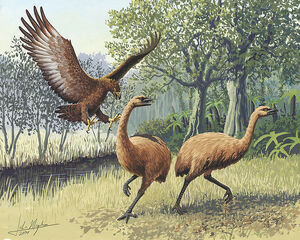(Adding categories) |
m (Replacing Flying things with Flying and Gliding (automatic)) |
||
| (3 intermediate revisions by one other user not shown) | |||
| Line 25: | Line 25: | ||
[[Category:Cryptid Wiki]] |
[[Category:Cryptid Wiki]] |
||
[[Category:Cryptids]] |
[[Category:Cryptids]] |
||
| − | [[Category:Flying |
+ | [[Category:Flying and Gliding]] |
[[Category:Theropods]] |
[[Category:Theropods]] |
||
[[Category:Australia/Oceania]] |
[[Category:Australia/Oceania]] |
||
| Line 32: | Line 32: | ||
[[Category:Australian Megafauna]] |
[[Category:Australian Megafauna]] |
||
[[Category:Raptors]] |
[[Category:Raptors]] |
||
| + | {{CryptidsNavBox}} |
||
Revision as of 18:38, 25 June 2019

Haast's eagle hunting for moa.
Poukai, Hakawai, Hokioi is carnivorous bird from Māori mythology, it was described by Sir George Grey, an early governor of New Zealand, as a huge black-and-white bird with a red crest and yellow-green tinged wingtips, and, in Māori legend, was said to kill and eat humans.
Mythology
In Māori mythology the Hakawai was one of eleven tapu, or sacred, birds of Raka Maomao, the god of the winds. The Hakawai lived in the heavens and only descended to the earth at night. It was considered to be a gigantic bird of prey.
Hearing the Hakawai was considered to be a bad omen, traditionally presaging war. Ornithologists in New Zealand have wondered whether the myth related to a real bird, whether extinct or still living.
Although mention of the Hakawai occurred in Māori mythology throughout New Zealand, in historic times (i.e. since European settlement of the main islands) direct experience of the Hakawai – through hearing the sounds it made – was largely restricted to the Muttonbird Islands, several small islands in the vicinity of Foveaux Strait and Stewart Island, in the far south of New Zealand. The islands have no permanent human residents but are visited seasonally, from mid March to the end of May, for muttonbirding – the harvesting of Sooty Shearwater chicks for food and oil. There the sound ascribed to the Hakawai was described as having two main components, the first part being vocal, a call rendered as “hakwai, hakwai, hakwai”, followed by a non-vocal roar as of an object travelling through the air at high speed. It was heard on calm, moonlit nights and appeared to come from a great height.
Investigation
During the 1980s ornithologist Dr Colin Miskelly, who was studying the New Zealand snipe genus Coenocorypha, after hearing and recording the aerial display of the Chatham Snipe (C. pusilla), investigated the possibility that the sounds attributed to the Hakawai in the Muttonbird Islands were made by the recently extinct South Island Snipe Coenocorypha iredalei, then usually called the Stewart Island Snipe and considered to be a subspecies of the Subantarctic Snipe Coenocorypha aucklandica, a small, unobtrusive, brown bird some 21–24 cm in length.
Miskelly interviewed several muttonbirders who had memories of hearing the distinctive sounds of the Hakawai. He found that its apparent range had steadily decreased over the years to the early 1960s when it was heard no more. The non-vocal sounds made by the Hakawai were described variously as “a sound as if a cable chain was lowered into a boat” a “jet-stream”, a “blind rolling itself up” or “a shell passing overhead”. The reaction to the sounds by those who heard it was generally one of fright.
The decrease towards extinction paralleled that of the South Island Snipe, of which the Muttonbird Islands were the final refuge, with the islands being progressively occupied by rats, feral cats and weka. The last known individuals of the snipe died in 1964 on Big South Cape Island following the accidental introduction of Black Rats there.
Explanation
Its commonly accepted to be Haast's Eagle (Harpagornis moorei), a monstrous eagle that once lived on the South Island of New Zealand and extinct around 1400.
A theory suggest that the legends refer to sound produced by several extinct Coenocorypha, genus of snipe from South Island.
Snipe in the genera Gallinago and Lymnocryptes, as well as the closely related woodcocks Scolopax, make courtship display flights, at dusk and on moonlit nights, producing mechanical sounds called 'drumming', 'bleating' or 'winnowing', through the vibration of their modified outer tail feathers caused by the rush of air in the course of a power dive. Of his research in the Chatham Islands Miskelly wrote:
”I studied Chatham Snipe on South East and Mangere .Islands during November 1983 to January 1984 and in July 1986, and recorded three different kinds of aerial displays. All these displays were performed at night; the most spectacular display included both a vocal and a non-vocal component. This display was indeed hair-raising when I first heard it. The vocal component was a disyllabic call, repeated five times, identical to one of the ground displays given by territorial male Chatham Island Snipe. This was followed by a loud roar, similar to a jet passing overhead, as the bird swooped over the 6 m canopy at high speed. The non-vocal component of the call had three stacked bands (0.7 kHz, 0.9 kHz & 1.2 kHz) and lasted for about 1.5 seconds.”
